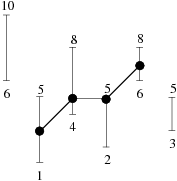TEMPERAT - Temperature
The Byteotian Institute of Meteorology (BIM) measures the air temperature daily. The measurement is done automatically, and its result immediately printed. Unfortunately, the ink in the printer has long dried out... The employees of BIM however realised the fact only recently, when the Byteotian Organisation for Meteorology (BOM) requested access to that data.
An eager intern by the name of Byteasar saved the day, as he systematically noted down the temperatures reported by two domestic alcohol thermometers placed on the north and south outside wall of the BIM building. It was established decades ago by various BIM employees that the temperature reported by the thermometer on the south wall of the building is never lower than the actual temperature, while that reported by the thermometer on the north wall of the building is never higher than the actual temperature. Thus even though the exact temperatures for each day remain somewhat of a mystery, the range they were in is known at least.
Fortunately for everyone involved (except Byteasar and you, perhaps), BOM does not require exact temperatures. They only want to know the longest period in which the temperature was not dropping (i.e. on each successive day it was no smaller than on the day before). In fact, the veteran head of BIM knows very well that BOM would like this period as long as possible. To whitewash the negligence he insists that Byteasar determines, based on his valuable notes, the longest period in which the temperature could have been not dropping. Now this is a task that Byteasar did not quite expect on his BIM internship, and he honestly has no idea how to tackle it. He asks you for help in writing a program that determines the longest such period.
Input
In the first line of the standard input there is one integer N (1 ≤ N ≤ 1000000) that denotes the number of days for which Byteasar took notes on the temperature. The measurements from day i are given in the line i+1 Each of those lines holds two integers, x and y (-109 ≤ x ≤ y ≤ 109). These denote, respectively, the minimum and maximum possible temperature on that particular day, as reported by the two thermometers.
Output
In the first and only line of the standard output your program should print a single integer, namely the maximum number of days for which the temperature in Byteotia could have been not dropping.
Example
For the input data:
6 6 10 1 5 4 8 2 5 6 8 3 5
the correct result is:
4

hide comments
|
|
karlo_2107:
2020-07-10 13:37:05
Can you give me some wierd test cases? I have WA...
|
|
|
smso:
2020-02-11 18:01:18
All the figures have gone. The links are dead. |
|
|
kingfran1907:
2020-01-11 16:54:19
note: n <= 10^6, -10^9 <= x <= y <= 10^9 |
|
|
anirudnits:
2018-12-31 07:12:19
can somebody provide me with some test cases, i can't seem to figure out what's wrong with my solution. Thanks. Last edit: 2019-04-11 13:24:08 |
|
|
Bhavik:
2013-10-20 14:37:59
my code is giving right ans for the given test case and test case provided in the comment section..
|
|
|
abhishek:
2013-08-28 16:44:56
my O(n) algo WA on testcase 17..plz help |
|
|
:D:
2012-06-17 12:13:28
Temperatures starting from second: 2 2 2 2. |
|
|
Rishi Bansal:
2012-06-12 12:24:48
can someone please explain how the answer for blashyrkh's test case is 4. since my algorithm is giving 3.
|
|
|
david_8k:
2011-12-30 20:23:43
Nevermind, it was a silly problem on my algorithm :D Thanks blashyrkh. |
|
|
Krzysztof Lewko:
2011-12-30 19:58:28
David, what's not clear in the problem ? |
| Added by: | Krzysztof Lewko |
| Date: | 2011-12-22 |
| Time limit: | 0.100s-1.510s |
| Source limit: | 50000B |
| Memory limit: | 1536MB |
| Cluster: | Cube (Intel G860) |
| Languages: | All except: ASM64 |
| Resource: | XVIII POI 2nd stage |

 RSS
RSS